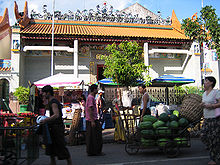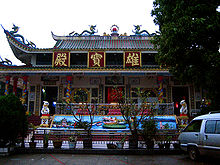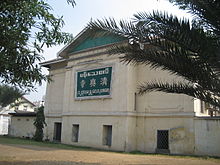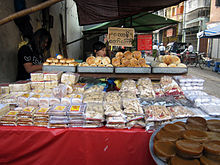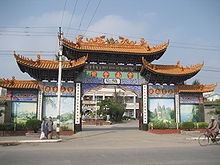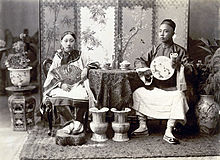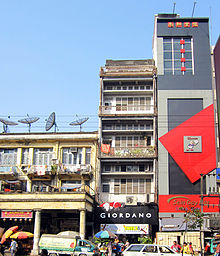- Chinese people in Burma
-
Burmese Chinese 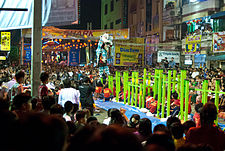
Lion dance performances in Yangon's Chinatown during Chinese New Year celebrations in 2011. Total population 1,662,000 (est.) Regions with significant populations Myanmar Languages Religion Predominantly Theravada Buddhism and/or Mahayana Buddhism, Taoism, Confucianism.
Minority Islam (mostly among Panthay)Chinese people in Burma Chinese name Traditional Chinese 緬甸華人 Simplified Chinese 缅甸华人 Transcriptions Mandarin - Hanyu Pinyin Miǎndiàn huárén Min - Hokkien POJ Biān-tián-tn̂g-lâng Burmese name Burmese 
တရုတ်လူမျိုး
MLCTS: ta. rut lu myui:
IPA: [təjouʔ lù mjó]The Burmese Chinese or Chinese Burmese (Burmese: မြန်မာတရုတ်လူမျိုး; also called Sino-Burmese) are a group of overseas Chinese born or raised in Burma (Myanmar). Although the Chinese officially make up three percent of the population, the actual figure is believed to be much higher. Among the under-counted Chinese populations are: those of mixed background;[1] those that have registered themselves as ethnic Bamar to escape discrimination; illegal Chinese immigrants that have flooded Upper Burma since the 1990s (up to 2 million by some estimates[2]) but are not counted due to the lack of reliable census taking.[3]
The Burmese Chinese dominate the Burmese economy today.[4] Moreover, the Burmese Chinese have a disproportionately large presence in Burmese higher education, and make up a high percentage of the educated class in Burma.
Contents
Etymology
In the Burmese language, the Chinese are called Tayoke (တရုတ်, tarut), pronounced [/təjouʔ/], and formerly spelt တရုပ် (tarup). The etymology of the term remains uncertain. The earliest evidence of this term dates to the Bagan era, in the 13th century, during which it referred to the territory and a variety of peoples to the north and northeast of Burma. Various scholars have proposed that it comes from the Chinese term for "Turk" (突厥, Tūjué); from the name of Dali (大理國, Dàlǐguó), the capital of the Kingdom of Nanzhao; a Chinese corruption of the term Dàyuèzhī (大月支 or 大月氏), a Chinese term referring to Mongol-speaking Kushan Huns.[5] The adoption of Tayoke to refer to the Han Chinese was not an established practice until the 19th century.[5]
In the Mon language, the Chinese are known as Krawk (ကြုက်, /krɜk/);[6] in Shan, they are called E (ၶႄႇ, /ɛ2/)[7]
Demography
Until the recent influx of Chinese immigrants from Yunnan, the Burmese Chinese in Lower Burma fell into three main groups:
- Hokkien (Burmese: eingyi shay အင်္ကျီရှည်, or let shay လက်ရှည် lit. long-sleeved jackets) from Fujian Province
- Cantonese (Burmese: eingyi to အင်္ကျီတို, or let to လက်တို lit. short-sleeved jackets) from Guangdong Province
- Hakka (Burmese: zaka စက, lit. mid-length sleeve) from Fujian and Guangdong provinces
The Hokkien and Cantonese comprised 45% of the ethnic Chinese population.[8] The Cantonese were originally dubbed "short sleeved jackets" because most migrants from Guangdong Province were artisans, wearing short-sleeve jackets, while most of the Hokkien were traders, wearing long-sleeved jackets.[9] These names remain in use today. Hakkas are further subdivided into those with ancestry from Fujian Province and Guangdong Province, called eingyi shay haka (အင်္ကျီရှည်ဟကာ) and eingyi to haka (အင်္ကျီတိုဟကာ) respectively. The groups have different stereotypical associations. The Cantonese are commonly thought of as the poorest of the Chinese, the Hokkiens are stereotypically wealthier, occupying high positions in the economy, and having connections to the government.
In Upper Burma and Shan Hills, the Panthay and Kokang, mainly speakers of a Mandarin dialect of the Southwestern Mandarin branch, most akin to Yunnanese, predominate. The mountain-dwelling, farming Kokang are classified as a part of the Shan national race, although they have no linguistic or genetic affinity to the Tai-speaking Shan, and the largely trading Muslim Panthay have long been considered separate local nationalities, distinct from the Chinese diaspora community. Combined, they form 21% of Burmese Chinese.[8]
Finally, there are the tayoke kabya (တရုတ်ကပြား) of mixed Chinese and indigenous Burmese parentage. The kabya (ကပြား, meaning "mixed heritage") have a tendency to follow the customs of the Chinese more than of the Burmese. Indeed, tayoke kabya who follow Burmese customs are absorbed into and largely indistinguishable from mainstream Burmese society.[10] A large portion of Burmese Chinese is thought to have some kabya blood, possibly because immigrants could acquire Burmese citizenship through intermarriage with the indigenous Burmese peoples.
Culture
Language
Most Burmese Chinese speak Burmese as their mother tongue. Those with higher education also speak Mandarin and/or English. The use of Chinese dialects still prevails. Hokkien (a dialect of Min Nan) is mostly used in Yangon as well as in Lower Burma, while Taishanese (a Yue dialect akin to Cantonese) and Yunnanese Mandarin are well preserved in Upper Burma.
During General Ne Win's rule (1962–1988), the ban on Chinese-language schools caused a decline of Mandarin speakers. The number of Chinese schools is growing again today because of the importance of Mandarin Chinese. (Note: Standard Mandarin refers to the national language of Mainland China and Taiwan, distinct from the Southwestern Mandarin dialect of the Upper Burma, Kokang and Panthay).
The Panthay Mosque (清真寺) in Mandalay serves the local Panthay community.
Religion
Most Burmese Chinese practice Theravada Buddhism, incorporating some Mahayana Buddhist and Taoist beliefs, such as the worship of Kuan Yin. There are several notable Chinese temples in Yangon, including Fushan Si Temple (a Buddhist temple), Kheng Hock Keong Temple (a Taoist temple dedicated to Mazu) and Guanyin Gumiao Temple (a Buddhist temple dedicated to Guanyin).
The Panthay or Chinese Muslims (回教華人; ပန်းသေးလူမျိုး, lit. "little flowers") practice Islam.
Education
The Burmese Chinese place a high importance on education, and represent a disproportionately high share of those with advanced (medical, engineering or doctorate) degrees in Burma. The number would be higher still had it not been for the longstanding ban on those without Burmese citizenship from pursuing advanced degrees. Nowadays, many wealthy Burmese Chinese send their children overseas—particularly in Thailand, Malaysia and Singapore, for advanced studies.[11] Taiwan is also a major destination, as the Taiwanese government offers aid and scholarship incentives to 'returning' overseas Chinese to study and settle there.[11]
Names
The Burmese Chinese have Burmese names and many also have Chinese names. Given names in various Chinese dialects are often transliterated into the Burmese language, using phonetic transcriptions or translated. For example, a Burmese Chinese person named 'Khin Aung' may have the Chinese name of 慶豐 (Hokkien POJ: Khèng-hong), with '慶' (Hokkien POJ: khèng) corresponding to 'Khin', and '豐' (Hokkien POJ: hong) corresponding to 'Aung'. However, variations of transcription do exist (between dialects), and some Burmese Chinese do not choose to adopt similar-sounding Burmese and Chinese names. Because the Burmese lack surnames, many Burmese Chinese tend to pass on portions of their given names to future generations, for the purpose of denoting lineage.
According to publications of Long Shan Tang, a clan association based in Yangon, the ten most common Chinese surnames in Yangon are:
Cuisine
Burmese Chinese cuisine is based on Chinese cuisine, particularly from Fujian, Guangdong and Yunnan provinces, with local influences. Spices such as turmeric and chili are commonly used. Also, the use of soy sauce, bean curd, bean sprouts, Chinese pickled mustards, and dried mushrooms can be attributed to Chinese influence. The following is a partial list of Chinese contributions to Burmese cuisine. These are an established part of today's Burmese cuisine, and are hardly differentiated as a foreign cuisine.
- Pauksi: steamed buns
- Bèkin: roasted duck
- Igyakway: fried Chinese doughnut
- Htamin kyaw: fried rice
- La mont: mooncake
- Mi shay: thin rice noodle soup
- Mi swan: thin wheat noodles
- San byoke: rice porridge
- Panthay khaukswè: Panthay-style fried noodles
- Sigyet khaukswè: literally "noodles laced in cooked oil," usually with chicken
History
Pre-colonial era
The earliest records of Chinese migration into present-day Burma were in the Song and Ming dynasties.[8] In the 18th century, Ming Dynasty princes settled in Kokang (the northern part of present-day Burma). Chinese traders, however, traveled as far as the capital city as well as northern towns on the Irrawaddy such as Bhamo. Some of them stayed and started a Chinese community at Amarapura, and when King Mindon moved his capital to Mandalay in 1859, the Chinese were the only community that decided to stay behind. Many of their descendants intermarried into the host society and remain important and respected citizens of Amarapura.
Colonial period
Another wave of immigration occurred in the 19th century under the British colonial administration. Britain encouraged immigration of Indians and Chinese to British Burma, and such incentives for work opportunities and enterprise and for accumulating wealth attracted many Chinese. They primarily came to Burma via British Malaya.[8] The Chinese quickly became dominant in the highly lucrative rice and gem industries. Many became merchants and traders owning both wholesale and retail businesses. Unlike in British Malaya, where most Chinese were coolie laborers, the Chinese in Burma were largely from the artisan and merchant classes.[10] Their success was reflected in the popular Burmese expression, "Earn like the Chinese, save like the Indian, and don't waste money like the Bamar." (ငွေကို တရုတ်လိုရှာ၊ ကုလားလိုစု၊ ဗမာလို မဖြုန်းနဲ့)
They integrated well into Burmese society not least because they, like the Bamar, were of Sino-Tibetan stock and were Buddhists, implicit in the nickname pauk hpaw (ပေါက်ဖော်, lit. "sibling").[12] During British rule, marriage between the Chinese and Burmese, particularly Chinese men and Burmese women, was the most common form of intermarriage in Burma, as evidenced by a High Court ruling on the legal status of Sino-Burmese marriages under Burmese Buddhist law.[13]
The Chinese are arguably the only other group of people the Bamar historically have a high regard for, not just for their ancient and uninterrupted civilization but for their skills and intellect as well. From 1935 until the end of British rule, the Chinese were represented in the colonial legislature, the House of Representatives.[14]
After World War II, displaced Burmese Chinese (whose pre-war homes were in Burma), were the most numerous group of overseas Chinese in Southeast Asia to request repatriation to return to Burma, according to the United Nations Relief and Rehabilitation Administration.[15]
Post-independence era
During the 1950s, Burma was one of the first countries to recognize the People's Republic of China as a nation. However, its own Chinese population was treated as aliens. The Burmese Chinese were issued foreign registration cards (FRC) in a tiered citizenship system adopted by the post-independence government. When the Chinese Communists expelled the Kuomintang, many fled to Burma and Thailand over the borders of Yunnan Province. The Burmese government fought and removed the armed KMT and forced them to Taiwan;[16] those who managed to stay prospered. In the 1950s, discriminatory policies against overseas Chinese encompassed citizenship, government employment, approval for business regulations and licensing, loan extensions and permission to make remittances.[17]
In 1952, Kheng Hock Keong Temple publications estimated that ethnic Chinese, who lived in enclaves in the area along Sinohdan, Latha, and Maung Khaing Streets (with Cantonese typically living above Maha Bandula Road and Hokkiens living below), constituted 9.5% of Rangoon's population.[18] During this period, there was a sharp rise in the number of private Chinese language schools, primarily teaching Mandarin Chinese, in Burma, from 65 in 1935 to 259 in 1953 and 259 at its peak in 1962, with many such schools affiliated to the Chinese nationalist (တရုတ်ဖြူ, lit. "White Chinese") or communist (တရုတ်နီ, lit. "Red Chinese") movements.[19] However, fewer than 10% of Burmese Chinese of school age attended Chinese language schools.[20] Similarly, about 80 clan associations operated in the 1950s.
Socialist rule
In 1962, Ne Win led the Socialist coup d'état, establishing the Revolutionary Council under the Burmese Way to Socialism. In February 1963, the Enterprise Nationalization Law was passed, effectively nationalizing all major industries and prohibiting the formation of new factories. This law adversely affected many industrialists and entrepreneurs, especially those without the full citizenship.[21] The government's economic nationalization program further prohibited foreigners, including the non-citizen Chinese, from owning land, sending remittances, getting business licenses and practicing medicine.[22] Such policies led to the beginnings of a major exodus of Burmese Chinese to other countries—some 100,000 Chinese left Burma.[16]
Although a kabya himself, Ne Win banned Chinese-language education and created other measures to compel the Chinese to leave. Ne Win's government stoked up racial animosity and ethnic conflicts against the Chinese, who were terrorized by Burmese citizens, the most violent riots taking place at the time of the Cultural Revolution in China in 1967.[16] All schools were nationalized, including Chinese language schools. Beginning in 1967 and continuing throughout the 1970s, anti-Chinese riots continued to flare up and many believed they were covertly supported by the government.[23] In 1967, Latha Secondary School was torched by the henchmen of Ne Win's government, where school girls were burnt alive. Similarly, Chinese shops were looted and set on fire. Public attention was successfully diverted by Ne Win from the uncontrollable inflation, scarcity of consumer items and rising prices of rice. The 1982 Citizenship Law further restricted Burmese citizenship for Burmese Chinese (as it stratified citizenship into three categories: full, associate, and naturalized) and severely limited Burmese Chinese, especially those without full citizenship and those holding FRCs, from attending professional tertiary schools, including medical, engineering, agricultural and economics institutions.[8] During this period, the country's failing economy and widespread discrimination accelerated an emigration of Burmese Chinese out of Burma.
Modern era
The Yangon Chinatown branch of the retailer Sein Gayha on 23rd Street also houses Ying Fo Fui Kun (應和會館), a Hakka Chinese clan association.
In 1988, the State Law and Order Restoration Council (SLORC) came to power, and gradually loosened the government's role in the economy, encouraging private sector growth and foreign investment. This liberalization of state's role in the economy, if slight and uneven, nonetheless gave the ethnic Chinese-led businesses extra space to expand and reassert their economic power. Today, the majority of retail, wholesale and import trade businesses are run by the Burmese Chinese today.[8] For example, Sein Gayha (စိန်ဂေဟာ), a major retailer that began in Yangon's Chinatown in 1985, is owned by a Hakka Chinese family. Moreover, four of the five largest commercial banks in Myanmar, Myanmar Universal Bank, Yoma Bank, Myanmar Mayflower Bank, and the Asia Wealth Bank, were all founded by Sino-Burmese.[24]
Today, the majority of Burmese Chinese live in the major cities of Yangon, Mandalay, Taunggyi, Bago, and their surrounding areas. Although there are Chinatowns (တရုတ်တန်း; tayoke tan) in the major cities, the Chinese are widely dispersed throughout the country. The northern region of Burma has seen an recent influx of mainland Chinese migrant workers, black market traders and gamblers. In Kachin State, which borders China in three directions, Mandarin Chinese is the lingua franca.
Upper Burma has seen a demographic shift resulting from the recent immigration of many Mainland Chinese to Mandalay Region, Shan,[25] and Kachin States.[26] Ethnic Chinese now constitute an estimated 30 to 40% of Mandalay's population.[27] Huge swaths of land in city centre left vacant by the fires were later purchased, mostly by the ethnic Chinese, many of whom were recent immigrants from Yunnan.[28] The Chinese influx accelerated after the current military government came to power in 1988. With the Burmese government turning a blind eye, many Chinese immigrants from Yunnan (and also from Sichuan) poured into Upper Burma in the 1990s, settling in Mandalay.[29] In the 1990s alone, about 250,000 to 300,000 Yunnanese were estimated to have migrated to Mandalay.[27] Their arrival has been vital in the doubling of Mandalay's population from about 500,000 in 1980 to one million in 2008. Chinese festivals are now firmly embedded in the city’s cultural calendar.[28] The influx of Mainland Chinese into the city and the subsequent displacement of native Burmese to the outskirts of the city has created racial tensions.[30]
There are also substantial Burmese Chinese communities outside of Burma, particularly in Taiwan, Macau, Hong Kong, Singapore, United States (such as New York City's Henry Street[31]) and Australia.[8][32][33] Zhonghe District, near Taipei, Taiwan is home to 40,000 Burmese Chinese (2008), one of the largest communities outside of Burma.[34]
Notable Burmese Chinese
- Aik Htun[35] (Kokang) - Managing director of Olympic Construction Co. and deputy chairman of Asia Wealth Bank, two large conglomerates in Burma
- Aung Gyi[16] - leading army dissident and Ne Win's former deputy/co-conspirator in the 1962 coup
- Aw Boon Haw (Hakka) - Inventor of Tiger Balm
- Aw Boon Par (Hakka) - Brother of Aw Boon Haw
- Edward Michael Law-Yone - Burmese journalist and founder of The Nation
- Khin Nyunt (Hakka) [36] - Former Prime Minister (2003–2004) and Chief of Intelligence (1983–2004) of Myanmar
- Khun Sa (Kokang) - Major Southeast Asian drug lord
- Kyaw Myint - founder of Myanmar May Flower Bank
- Lo Hsing Han (Kokang) - Major Southeast Asian drug lord
- Ne Win (Hakka)[37] - Leader of Burma from 1960s to 1980s
- Ngwe Gaing: Alinga Kyawzwa award-winning painter
- Pheung Kya-shin - leader of Kokang Special Region and Myanmar National Democratic Alliance Army
- San Yu (Hakka) - President of Burma (1981–1988)
- Serge Pun[38] - Proprietor of Yoma Bank, a major banking chain in Myanmar and chairman of First Myanmar Investment Co. Ltd (FMI), one of Myanmar's leading investment companies and Serge Pun & Associates Limited, an investment conglomerate[39]
- Taw Sein Ko (Hokkien)[40] - eminent Director of Archaeology (1901–1915)
- Thakin Ba Thein Tin[16] - Communist leader from the 1970s to the 1990s
- Tun Myint Naing[41] (Kokang) - Business tycoon
- Kat Sein - former Minister of Health
- Kyaw Myint - Minister of Health
See also
- Kokang people
- Panthay
- Overseas Chinese
- British Chinese
- Burmese diaspora
Further reading
- Mya Than (1997). "The Ethnic Chinese in Myanmar and their Identity". In Leo Suryadinata. Ethnic Chinese as Southeast Asians. Singapore: Institute of Southeast Asian Studies. ISBN 981-3055-58-8.
Notes
- ^ Hooker, Michael Barry (2002). Law and the Chinese in Southeast Asia. Institute of Southeast Asian Studies. ISBN 981-230-125-9.
- ^ Rieffel, Lex (2010). Myanmar/Burma: inside challenges, outside interests. Brookings Institution Press. pp. 95–97. ISBN 9780815705055.
- ^ "China's Ambitions in Myanmar". July 2000. http://www.asiapacificms.com/articles/myanmar_influence/.
- ^ Chua, Amy (2004). "Review: The Ethnic Question in Law and Development". World on Fire: How Exporting Free Market Democracy Breeds Ethnic Hatred and Global Instability (The Michigan Law Review Association) 102 (6): 1044–1103. doi:May, 2004. JSTOR 4141938.
- ^ a b Yian, Goh Geok (2009). "The question of ‘China’ in Burmese chronicles". Journal of Southeast Asian Studies (National University of Singapore) 41 (1). http://journals.cambridge.org/action/displayFulltext?type=6&fid=6881364&jid=SEA&volumeId=41&issueId=01&aid=6881360&fulltextType=RA&fileId=S0022463409990282.
- ^ Shorto, H.L. (1962). Dictionary of Modern Spoken Mon. Oxford University Press. http://sealang.net/mon/.
- ^ Sao Tern Moeng (1995). Shan-English Dictionary. ISBN 0-931745-92-6. http://sealang.net/shan/.
- ^ a b c d e f g Mya Than (1997). Leo Suryadinata. ed. Ethnic Chinese As Southeast Asians. ISBN 0-312-17576-0.
- ^ Chen, Yi-Sein (1966). "The Chinese in Rangoon during the 18th and 19th Centuries". Essays Offered to G. H. Luce by His Colleagues and Friends in Honour of His Seventy-Fifth Birthday. Volume 1: Papers on Asian History, Religion, Languages, Literature, Music Folklore, and Anthropology (Artibus Asiae Publishers) 23: 107–111. JSTOR 1522640.
- ^ a b Stamp, L. Dudley (1930). "Burma: An Undeveloped Monsoon Country". Geographical Review (American Geographical Society) 20 (1): 107–109. doi:Jan., 1930. JSTOR 209128.
- ^ a b Win, Htet (July 2004). "The Road To Riches?". The Irrawaddy. http://www.irrawaddy.org/article.php?art_id=3799&page=1. Retrieved 2006-06-05.
- ^ Aung, Pho Thar (2003-09-16). "Tango with China". The Irrawaddy. http://www.irrawaddy.org/article.php?art_id=381&page=1. Retrieved 2006-06-05.
- ^ Ikeya, Chie (2008). "The Modern Burmese Woman and the Politics of Fashion in Colonial Burma". The Journal of Asian Studies (Cambridge University Press) 67: 1299. doi:10.1017/S0021911808001782. http://journals.cambridge.org/action/displayAbstract?fromPage=online&aid=2541936.
- ^ Vandenbosch, Amry (1947). "The Chinese in Southeast Asia". The Journal of Politics (Cambridge University Press on behalf of the Southern Political Science Association) 9 (2): 89. doi:Feb., 1947. JSTOR 2125860.
- ^ "Repatriating China's Expatriates". Far Eastern Survey (Institute of Pacific Relations) 17 (4): 44–47. Feb. 25, 1948. JSTOR 3022741.
- ^ a b c d e Martin Smith (1991). Burma - Insurgency and the Politics of Ethnicity. London,New Jersey: Zed Books. pp. 153–154, 225–226, 98, 39.
- ^ Holmes, Robert A. (1967). "Burmese Domestic Policy: The Politics of Burmanization". Asian Survey (University of California Press) 7 (3): 188–197. JSTOR 2642237.
- ^ Lu, Hsin-chun Tasaw (Summer/Fall 2011). "Performativity of Difference: Mapping Public Soundscapes and Performing Nostalgia among Burmese Chinese in Central Rangoon". Asian Music 42 (2). http://muse.jhu.edu/journals/asian_music/v042/42.2.lu.html.
- ^ Murray, Douglas P. (1964). "Chinese Education in South-East Asia". The China Quarterly (Cambridge University Press on behalf of the School of Oriental and African Studies) (20): 78–80. doi:Oct. - Dec., 1964. JSTOR 651712.
- ^ Ibid. 80
- ^ Ibid. 190
- ^ Ibid. 191
- ^ Steinberg, David L. (2002). Burma: The State of Myanmar. Georgetown University Press. ISBN 0-87840-893-2.
- ^ Turnell, Sean (2009). Fiery dragons: banks, moneylenders and microfinance in Burma. NIAS Press. p. 261. ISBN 9788776940409.
- ^ Sai Zom Hseng (18 April 2011). "Wa People Rely on Chinese Wages for Survival". The Irrawaddy. http://irrawaddy.org/article.php?art_id=21127. Retrieved 25 July 2011.
- ^ Wai Moe (15 June 2011). "Instability Beckons in Wake of Kachin Conflict". The Irrawaddy. http://www.irrawaddy.org/article.php?art_id=21496. Retrieved 25 July 2011.
- ^ a b Poon Kim Shee (2002). "The Political Economy of China–Myanmar Relations: Strategic and Economic Dimensions". Ritsumeikan Annual Review of International Studies (Ritsumeikan University). http://www.ritsumei.ac.jp/acd/cg/ir/college/bulletin/e-vol1/1-3shee.pdf.
- ^ a b Min Lwin (April, 2009). The Chinese Road to Mandalay. The Irrawaddy. http://www.irrawaddy.org/article.php?art_id=15404.
- ^ Stephen Mansfield (1999-05-13). "Myanmar's Chinese connection". Japan Times. http://search.japantimes.co.jp/cgi-bin/fv19990513a2.html.
- ^ Kyi Wai (8 July 2011). "Dangerous Anti-Chinese Discontent Growing in Mandalay". The Irrawaddy. http://irrawaddy.org/article.php?art_id=21656&page=2. Retrieved 25 July 2011.
- ^ Maffi, Mario (1994). Gateway to the promised land: ethnic cultures on New York's Lower East Side. Rodopi. pp. 22. ISBN 9789051836776.
- ^ Richter, Frank-Jürgen (1999). Business networks in Asia: promises, doubts, and perspectives. Greenwood Publishing Group. pp. 186. ISBN 9781567203028.
- ^ Kathleen Nadeau, Jonathan H. X. Lee, Kathleen M. Nadeau, ed (2010). Encyclopedia of Asian American Folklore and Folklife. ABC-CLIO. pp. 56. ISBN 9780313350665.
- ^ Lu, Hsin-chun Tasaw (2008). "Festivalizing Thingyan, Negotiating Ethnicity: Burmese Chinese Migrants in Taiwan". Journal of Burma Studies 12: 30. http://muse.jhu.edu/journals/journal_of_burma_studies/v012/12.lu.html.
- ^ Backman, Michael (2003-03-30). "Burma's banking meltdown goes unnoticed beyond its borders". The Age. http://www.theage.com.au/articles/2003/03/19/1047749824134.html. Retrieved 2006-06-22.
- ^ Kuppuswamy, C.S. (2004-09-11). "MYANMAR: The shake- up and the fall out.". South Asia Analysis Group. Archived from the original on 15 December 2005. http://web.archive.org/web/20051215070939/http://saag.org/papers12/paper1161.html. Retrieved 22 May 2006.
- ^ Leong, S.T. (1997). Migration and Ethnicity in Chinese History. Stanford University Press.
- ^ Backman, Michael (2003-03-30). "Burma's banking meltdown goes unnoticed beyond its borders". The Age (The Age). http://www.theage.com.au/articles/2003/03/19/1047749824134.html. Retrieved 2006-06-22.
- ^ Zaw Htet (2006-11-13). "FMI profits beat the business blues". The Myanmar Times. http://www.myanmar.com/myanmartimes/MyanmarTimes18-342/b001.htm. Retrieved 2006-11-26.
- ^ Strachan, Paul (1989). Pagan - Art and Architecture of Old Burma. Kiscadale.
- ^ Wai Moe (22 July 2011). "Steven Law’s Rising Empire". The Irrawaddy. http://irrawaddy.org/article.php?art_id=21748. Retrieved 25 July 2011.
External links
- Newidea! Myanmar information Web Site
- Burma Overseas Chinese Student Association
- Overseas Chinese Affairs Office of the State Council of the People's Republic of China (Chinese-language only)
- Overseas Chinese Affairs Commission, R.O.C.
- Chronology of Chinese-Burmese Relations of The Irrawaddy
Overseas Chinese Africa Eastern AfricaEthiopia · Kenya · Madagascar · Mauritius · Mozambique · Réunion1 · Seychelles · Tanzania · Uganda · ZambiaElsewhereAmericas ElsewhereArgentina · Brazil · Canada (from Hong Kong) · Chile · Costa Rica · Mexico · Nicaragua · Panama · Peru · United States (Laotian Chinese)Asia Central AsiaEast AsiaSouth-East AsiaSouth AsiaWest AsiaEurope Bulgaria · Czech Republic · Denmark · France · Germany · Italy · Netherlands · Portugal · Romania · Russia · Serbia · Spain · Turkey · United Kingdom (from Hong Kong)Oceania 1 An overseas department of France in the western Indian Ocean. See also: Hong Kong Diaspora Categories:- Ethnic groups in Burma
- Chinese diaspora
Wikimedia Foundation. 2010.

